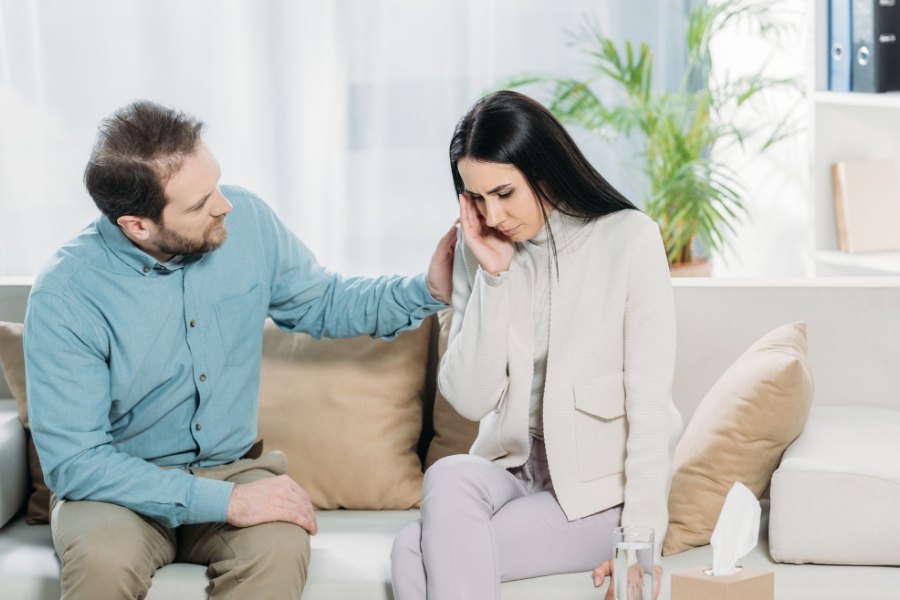How to Help Someone with Depression and Anxiety Disorder in 2022
Daily life challenges take a heavy toll on people all over the world, in one way or another, and our loved ones and others need us to support their mental and emotional health more than ever. In these dark times, you may begin to wonder how to be a source of light to others by understanding how to help someone with depression and anxiety disorder.
You may notice someone is depressed when they have persistently sour moods and an abject and enduring lack of interest in participating in activities. This state of mind and manner of behavior can cause considerable impairment in their daily lives.
Anxiety, on the other hand, is a mental health disorder that plagues its victim with lingering feelings of worry or fear that are powerful enough to affect the person’s daily activities.
Anxiety and depression are mostly born due to the totality of biological, psychological, and social sources of distress that people face.
If you or someone close to you is exhibiting these signs, worry no more. Here are twenty surefire steps on how to help someone with depression and anxiety disorder.
How to Help Someone with Depression and Anxiety Disorder

Depression and anxiety are severe disorders that affect people from all walks of life, both the young and the old. Hence why it is most likely, you know someone who is a victim, and you are wondering how to help someone with depression and anxiety disorder.
The good news is that depression and anxiety are treatable disorders. Here are some golden tips on how to help someone with depression and anxiety disorder.
1. Do Not Underestimate The Seriousness Of Depression And Anxiety: As much as you may be frustrated with the signs of depression and anxiety disorder in an individual, those going through it can not quickly move on from it or get over it in the blink of an eye.
Depression and anxiety are like sinks that drain an individual of their vigor, optimism, and happiness. To connect with them, you must first acknowledge they are going through no easy feat. Empathize with them and remind them of how strong they are for making it this far despite their challenges.
2. Concealing Their Disorder Won’t Make It Go Away: Another significant factor in how to help someone with depression and anxiety disorder is to let them know that pretending to be okay will not make their current condition go away. If anything, it shoves the victims more in-depth into the cages of depression and anxiety than anything else. Acknowledging their disorder is not a weakness. It is a remarkable display of strength.
3. Making Excuses For A Person With Depression And Anxiety Serves Them No Good: When attempting to understand how to help someone with depression and anxiety disorder, it is essential to remember that covering up for a family member, acquaintance, or friend who is suffering from depression and anxiety in hopes of protecting them will serve as the opposite.
Just as preventing someone who is bleeding on the outside from getting help is hugely detrimental to their survival, pretending someone who is bleeding on the inside is fine is just as dangerous.
4. Encourage A Victim Of Depression And Anxiety Disorder To Seek Professional Help: Unfortunately, in the world today, there is a romanticization of emotional suffering. People often disregard depression and anxiety as disorders. Individuals suffering from these disorders may be misconstrued as weak or may see themselves as such.
This toxic method of self consideration may create some stigma and wariness in victims towards seeking professional help, as victims fear being seen as mentally deranged or weak.
A successful tip on how to help someone with depression and anxiety disorder is to encourage them to seek professional help and support them through their visits, as well as protect their privacy for the duration of their treatment.
Please wait a minute! Apart from constantly publishing meaningful content here as the owner of this blog, I am also a fast-rising artiste who need your support by simply subscribing to my YouTube channel. Thank you so much.
How to Help Someone with Depression and Anxiety Who Doesn’t Want Help

Now, you have come to understand that concealing the depression and anxiety disorder that your family member or friend may have is the opposite way of how to help someone with depression and anxiety disorder.
The realization that the only way through may lead you to wonder how to help someone with depression and anxiety who doesn’t want help.
To avoid doing more harm than good or lose your family or friend to the prisons of depression and anxiety disorder for good, here are some helpful tips on how to help someone with depression and anxiety who doesn’t want help.
5. Understand That You Cannot “Cure” Someone Else’s Depression: I know what you are thinking. This heading does not mean that individuals battling depression and anxiety disorder cannot reach a healthy place where their depression and anxiety do not hold power over them anymore. What this heading means is that it is not your solemn duty to cure someone else’s depression and anxiety.
You are not to blame for what is happening to them, and their happiness is not your sole purpose on earth. When you decide to help someone out of their depression and anxiety, you must understand that all you can do is offer them as much support and love as you humanly can. It is up to the individual to make do of that.
Embracing a savior’s role in helping someone battling depression and anxiety can drag you by the ankles into the very trenches of depression and anxiety that you are trying to save someone else. It can also push them far away from you if you do not tread less invasively.
6. Understand The Appropriate Methods Of Approach: Depression and anxiety eat away at one’s self-esteem. It creates an alternate universe in one’s mind where every situation is replayed in a negative light. Individuals suffering from depression and anxiety lie in a dangerously delicate place: they not only believe they are a failure and are despised by or disconnected from the people around them, but they also do not want to feel pressured or suffocated any further.
So, to be of meaningful help to them, you must know how to approach them without suffocating them. You can achieve this by giving the victims space when they ask for it and offering reassuring statements such as “I do not think you are hopeless,” “I love you as you are now,” “I want you to be happy,” and most importantly, “I will always be here for you.”
These statements seem like a low effort on your part, as you may instead prefer to break down their doors and drag them out of the prisons in their heads and into the real world. But these statements will unlock the doors with ease instead.
7. Be A Good Listener: When trying to help someone with depression and anxiety, you must establish a system of trust. The first tip towards establishing trust is to be a good listener.
This is not as easy as you think. Listening to the thoughts and feelings of a victim without offering what you might consider well-meaning advice, interrupting with a personal story of yours, and telling them to simply get over it by going out into the world and not languishing in loneliness is an excellent way to start.
8. Avoid Trigger Terms When Trying To Establish Trust: When you are trying to establish trust with a victim of depression and anxiety disorder, there are some trigger statements you may offer with good intentions. Be sure to avoid these statements exactly or in variations. They include words such as,
• You should have gotten over this issue by now.
• It is all in your head.
• Everyone goes through rough patches.
• Just get your mind off it.
• Look on the brighter side of things.
How to Help Someone With Depression and Anxiety Over Text

Sometimes your family member or loved one might be drowning in rough waters and may not want to be in the physical company of others. You may begin to wonder how to help someone with depression and anxiety disorder.
Thankfully, today, there are more straightforward means of communicating with someone without necessarily being in their presence. Below are helpful tips if you are wondering how to help someone with depression and anxiety over text.
9. Do Not Push: As much as you want to know your loved one is happy and okay, it is often better to give them some space after texting them. Too much pressure can set them off and may propel them towards responding negatively to you when they otherwise would not. Remember, what is worth it is worth waiting for.
10. Be Understanding: When your loved one eventually responds to your messages, you may naturally feel upset about how long they took to get back to you. But remember what they are going through and how much they fought to pull themselves above murky waters to communicate with you.
Words such as, “You can always respond to me when you can,” “I am not upset,” and “I am happy to hear from you” can encourage a person going through depression and anxiety to communicate with you frequently.
11. Sometimes, Ignore The Elephant In The Room: When trying to help someone going through tough times due to depression and anxiety, every conversation does not have to be about the victim’s pain and anguish.
Be a breath of fresh air in their moments of suffocation. Talk about funny subjects, share a link to funny posts, ask them about their interests, and softly encourage them to participate in them more infrequently. Send them books, games, food, home workout videos, or any other feel-good activity, and this will surely be of great help.
12. Do Not Treat Them Like They Are Fragile: Indeed, persons dealing with depression and anxiety are not in a positive state of mind, but this is no excuse to treat them like fine china.
It comes off as insulting to your person of concern when you withhold information –be it good news or bad news–because you worry about their mental state. Always keep them in the loop while ensuring you apply the previous tips to communicate with them effectively.
How to Help Someone with Depression and Social Anxiety

As you go through these tips on how to help someone with depression and anxiety disorder, you may realize yet never fully comprehend
how harrowing it is to feel isolated in oneself and disassociated from others unless you suffer from social anxiety.
Social anxiety is a chronic mental health condition in which social interactions cause an irrational anxious feeling. Social anxiety can create constant trauma for victims as triggers lie waiting through every social interaction, and, inevitably, depression.
But such victims do not have to be alone in their dark times. Here are some tips on how to help someone with depression and social anxiety
13. Understand Why They Behave The Way They Do: Mining for gold is no easy feat, and you must unearth and go through a lot of muck to reach the bedrock. Yet, like the light at the end of a tunnel, something precious and utterly worth it awaits you. This situation also applies when trying to help someone with depression and social anxiety.
It is easy to mistake someone with depression and social anxiety as a snob. Such persons tend to respond with little to no words, isolate themselves when in a group, and not socialize in parties or other social gatherings. They may also hide behind figurative blankets like earpieces, hoodies, and phones.
Victims behave this way because the world is much noisier and dizzying to them than others. What to you might be a simple question is a ticking blast that they need to defuse before responding to you. When you offer them a gentle hand and patience instead of calling them out, speaking negatively to them, or forcing them into the spotlight, you have gone a long way towards easing the restraints of their disorder.
14. Do Not Enable Their Disorder: If humans were meant to hide from society at any moment of discomfort, then we would come with shells that we can hide in to protect ourselves. Our dispossession of these shells shows that we must have to be present at uncomfortable moments.
So if you have developed a habit of speaking on behalf of your family member or friend who has social anxiety or helping them avoid social gatherings as a means of protecting them, you must begin to unlearn this behavior. Instead, work on easing them into these situations as well as getting others to understand them better.
15. Never Play The Blame Game: Social anxiety disorder is no one’s fault. Blaming yourself for the fact that your family member or friend has depression and social anxiety disorder or blaming the victim will do nothing but worsen matters.
Social anxiety disorder occurs due to psychological and biological factors that are beyond the control of anyone.
16. Be Generous But Not Patronizing With Your Compliments: Another critical tip on how to help someone with depression and anxiety over text is to acknowledge the efforts they make towards being socially active. What might seem to you like a little participation or even fun may have taken a lot of effort on their part.
But do not be patronizing towards them, as if they were toddlers.
How to Help Someone with Postpartum Depression and Anxiety

As you read through these critical tips on how to help someone with depression and anxiety disorder, you begin to understand that depression and anxiety are potent disorders that can plague even the strongest of us. But this can be even worse for new mothers.
When looking into how to help someone with postpartum depression and anxiety, the following pointers may prove to be very resourceful.
17. Understand The Symptoms Of Postpartum Depression In New Mothers: Postpartum depression can appear a lot like baby blues, as they have similar symptoms such as mood swings, insomnia, sadness, and irritability. Yet postpartum symptoms are more severe and longer-lasting. Here are the significant signs of postpartum depression to aid your quest on how to help someone with postpartum depression and anxiety.
• New mothers suffering from postpartum depression and anxiety will find it most difficult to connect with their partners or bond with their baby. If you are a husband or family member, you will find that your wife or loved one feels like a stranger. As though she is in her world and there is a veil dividing you and the baby from her. These pointers mentioned above are a sign that she is suffering from postpartum depression and anxiety.
• A lingering feeling of worry that prevents new mothers to find time to relax or succumb to sleep, even when their newborn is fast asleep. They feel an urgency always to be awake and attend to something that may not even need urgent attention, at the detriment of their peace of mind as well as their health.
• An overpowering feeling of emptiness and a lack of self-worth: Mothers suffering from postpartum depression and anxiety become preoccupied with dangerously negative thoughts that can be harmful to their life if not attended to.
• Postpartum Psychosis is a rare case that occurs within fourteen days following delivery. Postpartum psychosis is characterized by paranoid and irrational beliefs, hallucinations, thoughts of harming the newborn, confusion and disorientation, irrational behavior,
extreme agitation and anxiety, and more.
18. Acknowledge And Engage Her When You Are Around: When in the presence of a mother and her newborn, you might be so caught with the newborn or even believe your obsession with the newborn is what a new mother wants from you. Still, your failure to acknowledge and engage her, outside of discussions about how cute her baby is, can be detrimental to her mental and emotional state.
Be there to listen to her often and let her know her emotions are valid.
19. More Doing, Less Asking: You may consider yourself doing the best you can when you tell a woman with postpartum depression and anxiety that you are there for her, and she should let you know whatever it is she needs.
This seemingly helpful statement puts unnecessary pressure on the new mother to organize her thoughts and feelings. Instead, pay attention to what is stressing her most and attend to that.
If she seems tired, take the baby for a few hours and allow her to get some much-needed rest. If she is stressing over laundry, offer to help her do it instead. Help her get groceries or encourage her to take a nice evening walk while you attend to things at home.
These gestures will go a long way in helping new mothers out of postpartum depression and anxiety.
20. Remind Her That This Too Shall Pass: When a new mother is experiencing postpartum depression and anxiety, she may feel that drowning and dissociation are her new identity. At such critical points in her life, it becomes essential to remind her that this is only temporary and that she will soon begin to feel like herself again.
You can encourage her to join a support group of mothers going through postpartum depression and anxiety – be it online or offline. You can also research cases of mothers who have successfully overcome postpartum depression and anxiety and share them with her. She must know that she is not alone and that what she is going through is not particular to her alone.
This concludes our 20 surefire tips on how to help someone with depression and anxiety disorder. You came in with pressing questions about depression and anxiety and, built up with these tips, you will surely be the light in a particular person’s dark times.
Depression and anxiety disorder cases are more common than you think. So do not hesitate to be a hero by sharing this article on your social media platforms with people who will no doubt benefit from learning about how to help someone with depression and anxiety disorder. Don’t forget to leave a comment below to ascertain what you have learned. Cheers!




![How To Eat Vegetables When You Hate Them: [20 Proven Tips]](https://vieforth.com/wp-content/uploads/2021/04/How-To-Eat-Vegetables-When-You-Hate-Them-768x512.jpg)
![How To Stop Anxiety Eating Forever: [8 Effortless Tips]](https://vieforth.com/wp-content/uploads/2021/07/How-To-Stop-Anxiety-Eating-768x512.jpg)
![Psychology of Weight Loss Motivation: [20 Guaranteed Tips]](https://vieforth.com/wp-content/uploads/2021/04/Psychology-of-Weight-Loss-Motivation-768x512.jpg)